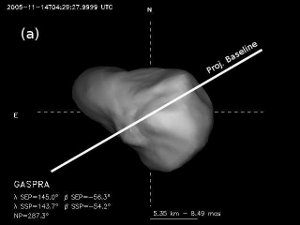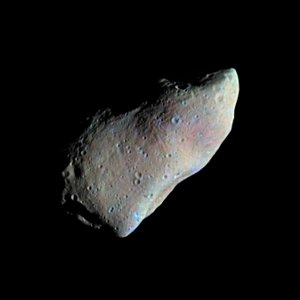Asteroid (234) Barbara is an unusual object, a denizen of the main belt that may be a binary. The European Southern Observatory’s Very Large Telescope Interferometer is able to piece together two bodies, with diameters of 37 and 21 kilometers respectively, separated by a bit over 20 kilometers. But as seen from Earth, the objects seem to overlap, so we don’t know whether this is a true binary or an asteroid in the shape of a giant peanut. The former would be more interesting, for if we can calculate the orbits of these objects and combine them with diameter measurements, we’ll learn about their density.
This is why Sebastiano Ligori (INAF-Torino, Italy) calls Barbara “…a high priority target for further observations.” Ligori is one of the researchers who used the combined light from two of the Very Large Telescope’s 8.2-meter instruments to make these interferometric studies, creating a view as sharp as a single telescope whose diameter is as large as the separation between the two. The image of asteroid (951) Gaspra just below gives an idea of the method’s powers — compare it to the subsequent photo of Gaspra taken by the Galileo spacecraft.

Image (left): Shape model of (951) Gaspra projected on the plane of the sky at the time of the second VLTI visibility measurement. Credit: Marco Delbo/ESO.
From a broader perspective, these interferometric methods give us an unprecedentedly sharp view of distant asteroids, being able to resolve main belt objects down to about fifteen kilometers in diameter. Thus we increase the number of objects we can measure, giving us a better window into the early days of the Solar System, when debris was coalescing into larger bodies. According to this ESO news release, an observing campaign using interferometric methods will now begin in an attempt to characterize more of the smaller asteroids.

Asteroid specialists clearly have a long way to go. The European Space Agency’s Gaia mission should, within the next ten years or so, deliver mass information for 100 or so of the largest main belt asteroids, and according to the paper on the VLTI work, should be able to directly measure the size of all main belt objects larger than 30 kilometers (roughly a thousand asteroids). But the burgeoning study of binary asteroids suffers from these size limitations, and the new VLTI work offers one way to deliver accurate information about smaller objects. Neither adaptive optics nor radar is up to that challenge.
Image: A 1991 image of asteroid (951) Gaspra taken by the Galileo spacecraft. Credit: JPL.
The paper is Delbo et al., “First VLTI-MIDI direct determinations of asteroid sizes,” in press at the Astrophysical Journal and available here.


Remotely mapping asteroids is quite a feat and the VLTI is only making it easier, and allowing us to be more confident of the results. It does make hiding places for ETIs in the Solar System rarer too – or does it raise the prospect of spotting artificial structures via passive observation? Would we recognize an alien space-colony if we saw it? Traces of mining? Would an artificial structure be unusually symmetrical? Would an abandoned asteroid base look like an eroded natural object in a few million years?
We’ll only know if we watch the skies…
I like that, Adam. I am a writer and I have been thinking of using asteroid (234) Barbara as a human settlement in a scifi story, but I like you’re idea better. There could be an alien listening-station hidden within the myriad of asteroids in the main belt or any part of our local solar system.
Space is BIG … most people haven’t stopped to think about how big it is since Billy Bob Thornton talked about it in “Armageddon.” Point is, there are thousand’s of places that alien observers can hide.
I wonder what they would observe. Hey, maybe they’re reading this post right now. . .I’m onto you, you alien conspirators! I don’t know where you are, but as God as my witness, I hereby devote my life to finding you!
Will anyone join me? All I’m gonna need is someone to invent a way for me to get into space. Something cozy, please, ‘cuz I’ve got a lot of asteroids to visit.
LET’S DO IT!!!
EURONEAR – Data Mining of Asteroids and Near Earth Asteroids
Authors: O. Vaduvescu, L. Curelaru, M. Birlan, G. Bocsa, L. Serbanescu, A. Tudorica, J. Berthier
(Submitted on 27 Jun 2009)
Abstract: Besides new observations, mining old photographic plates and CCD image archives represents an opportunity to recover and secure newly discovered asteroids, also to improve the orbits of Near Earth Asteroids (NEAs), Potentially Hazardous Asteroids (PHAs) and Virtual Impactors (VIs). These are the main research aims of the EURONEAR network.
As stated by the IAU, the vast collection of image archives stored worldwide is still insufficiently explored, and could be mined for known NEAs and other asteroids appearing occasionally in their fields. This data mining could be eased using a server to search and classify findings based on the asteroid class and the discovery date as “precoveries” or “recoveries”.
We built PRECOVERY, a public facility which uses the Virtual Observatory SkyBoT webservice of IMCCE to search for all known Solar System objects in a given observation. To datamine an entire archive, PRECOVERY requires the observing log in a standard format and outputs a database listing the sorted encounters of NEAs, PHAs, numbered and un-numbered asteroids classified as precoveries or recoveries based on the daily updated IAUMPC database.
As a first application, we considered an archive including about 13,000 photographic plates exposed between 1930 and 2005 at the Astronomical Observatory in Bucharest, Romania. PRECOVERY can be applied to other archives, being intended as a public facility offered to the community by the EURONEAR project.
This is the first of a series of papers aimed to improve orbits of PHAs and NEAs using precovered data derived from archives of images to be data mined in collaboration with students and amateurs. In the next paper we will search the CFHT Legacy Survey, while data mining of other archives is planned for the near future.
Comments: Accepted in Astronomische Nachrichten (Feb 2009)
Subjects: Instrumentation and Methods for Astrophysics (astro-ph.IM)
Cite as: arXiv:0906.5030v1 [astro-ph.IM]
Submission history
From: Ovidiu Vaduvescu [view email]
[v1] Sat, 27 Jun 2009 02:48:38 GMT (353kb)
http://arxiv.org/abs/0906.5030